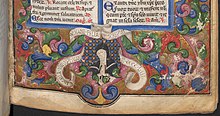Maria Ormani (born Maria di Ormanno degli Albizzi; 1428 - c. 1470), was an Italian Augustinian Hermit nun-scribe and manuscript illustrator.[1]
She was the grand-daughter of Rinaldo degli Albizzi, leader of the aristocratic Guelph party of Republic of Florence; both her father Ormanno and grandfather Rinaldo were exiled when the Medici family returned to Florence in 1434. Maria lived through the turmoil of their condemnation, departure, and confiscation of family properties during this exile. In 1438 she entered the convent of Santa Caterina al Monte, known as San Gaggio, located just outside the walls of Florence. The nuns of San Gaggio formed an elite community with an outstanding library inherited from Cardinal Pietro Corsini. They copied their own breviaries and manuscripts for the Augustinian friars at Santo Spirito, Florence, and for the new Augustinian female convent of Santa Monaca.[1] They were also active in the textiles industry and produced fine linens and gold thread.[2]

Maria di Ormanno degli Albizzi's most notable work is an apparent self-portrait in a breviary (Ms. Cod. 1923, Oesterreichische Nationalbibliothek, Vienna) that she signed and dated 1453.[3] This is the earliest dated self-portrait by a woman artist in Italian Renaissance art. Her image is framed by a scroll with a Latin inscription describing her as "handmaid of God, daughter of Orman, and the writer of the book."[4] Her inscription gives her father's first name, but drops the family surname. Maria sketched her countenance in silverpoint in the bas-de-page of the Advent frontispiece, but did not paint the border or most initials. Based on the style, the breviary's other initials and borders were finished by north Italian illuminators in the 1470s.[1] Maria's portrait differs from Florentine secular women's portraits of the mid-fifteenth century in its frontal pose and direct "self-possessed" gaze.[5]
- ^ a b c Arthur, Kathleen G (2017). "New Evidence for a Scribal-Nun's Art: Maria d'Ormanno degli Albizzi at San Gaggio". Mitteilungen des Kunsthistorischen Institutes in Florenz. LIX:2. Kunsthistorisches Institut in Florenz, Max-Planck-Institut: 271–279 – via academia.edu.
- ^ Strocchia, Sharon T. (2009) Nuns and Nunneries in Renaissance Florence, Baltimore: Johns Hopkins University Press, pp.126-131.
- ^ "Ormani, Maria (fl 1453)". Women in World History: A Biographical Encyclopedia (Encyclopedia.com). Gale Research Inc. 2002. Retrieved 3 March 2017.
- ^ Borzello, Frances (1998). Seeing Ourselves: Women's Self-Portraits. New York: Harry N. Abrams. p. 38.
- ^ Arthur, Kathleen G. (2005). "Maria Ormani: Fashioning a Noble image for an Augustinian Hermit Nun". SECAC Review. XIV (5). Retrieved 3 March 2017.